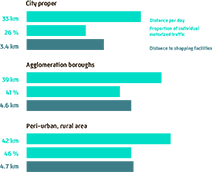3
Spatial Planning
Reduces Traffic Congestion
Kindly supported by Cinémathèque suisse.
Place: Central Switzerland
Interview: Thomas Hochreutener, Retail Expert
Spatial planning provides for more compact settlements in which the distances to schools, shops, recreational areas and workplaces are short. The densification of settlements close to public transport stops or stations means that spatial planning also reduces car traffic.
In the last few decades, we have predominately built a settlement structure that has forced us to travel more often and further away – mostly by car. For example, we have to drive to the shopping center because most of the local shops have disappeared. This has resulted in higher traffic volume, more commuters, more traffic jams, ugly parking lots and larger surface area usage. The goal of spatial planning is to allow for settlements that are sufficiently populated in order to provide local shops with enough customers. Other amenities, such as cinemas, sports facilities and, not least, workplace should be within walking distance or accessible by bicycle or via public transport.
The future of planning lies in compact settlements because they shorten the distances that have to be covered. In order to ensure the efficient utilization and affordability of public transport, more people have to live and work close to train stations and bus stops. And this is the only way to limit the continuing increase of car traffic with its negative effects, such as noise pollution, air pollution due to exhaust fumes and increased energy usage. The growing population and increasing job opportunities have to be directed towards existing settlements and locations that are well connected via public transport.
Transport Patterns by Residential Location

